Hawker Hunter Fighter - Air Hunter
Hunter fighter (English “Hunter”) became, perhaps, the most successful in terms of a complex of characteristics and commercially successful on the foreign market by a British jet fighter in the 50-70-s. In terms of the number of British combat jets sold to foreign customers, the Hunter could only compete with the Canberra front-line jet bomber, which was being built at the same time as its serial production. "Hunter" showed an example of rare longevity, becoming one of the symbols of the British aviation industry.
In 1950, the British Royal Air Force, which is part of the UN Forces, in Korea, collided with Soviet MiG-15 fighter jets. The British Sea Fury piston fighters and the Meteor jet fighters, which were available to the British at that time, could not fight on equal terms with the MiGs. In addition, the test of nuclear charge in the USSR on August 29, 1949 and the commenced production of long-range Tu-4 bombers put Britain in a very difficult situation. In general, the British were quite satisfied with the American F-86 Saber fighter jet, but national pride and a desire to support their own aviation industry did not allow the purchase of Sabers, although the Americans were ready to assist in setting up licensed construction of this rather successful fighter.
Since 1948, Hawker has been working on creating a fighter with swept wings and transonic speeds. As conceived by Sydney Kamm, Chief Designer of the Hawker, the new British fighter, due to its greater range and more powerful weapons with comparable speed and maneuvering characteristics, was to surpass the American rival. Initially, the main task of the fighter saw the struggle with the Soviet bombers. British strategists, based on the experience of the Second World War, assumed that the interceptors, induced by ground-based radar commands, would be met by enemy bombers at a considerable distance from the coast. However, the events in Korea and the sharply increased characteristics of combat aircraft made adjustments to these plans, and the rather slow research at Hawker had to be dramatically accelerated, and as further events showed, the main task of the projected aircraft was by no means a struggle with low-speed and low-level bomber aircraft.
The Hawker jet fighter was an all-metal monoplane with a mid-swept wing and one turbojet engine. The angle of sweep of a wing is 40 degrees along the line of quarters of chords, the coefficient of elongation is 3,3, the relative thickness of the profile is 8,5%. In the root of the wing were air intakes. The aircraft had a retractable landing gear with a front wheel. The fuselage is a semi-monocoque type made of aluminum alloys.
From the very beginning, Air Force representatives insisted on armament consisting of four 20-mm guns. But the designers of the company managed to convince the military that the latest 30-mm Aden air cannons (the British version of the Mauser MG 213 cannon) would make the fighter much more effective in fighting air targets. And although later “Hunter” didn’t carry out air battles too often, powerful artillery weapons had to be very useful when performing percussion missions. Ammunition was very solid and was 150 shells on the barrel.
In the autumn of 1950, the Hawker firm received an order from the Royal Air Force Command to speed up work and to launch a new, still flightless fighter as soon as possible into mass production. However, despite the increased pace of design, the prototype, known as the R. 1067, took off only 20 July 1951 of the year.
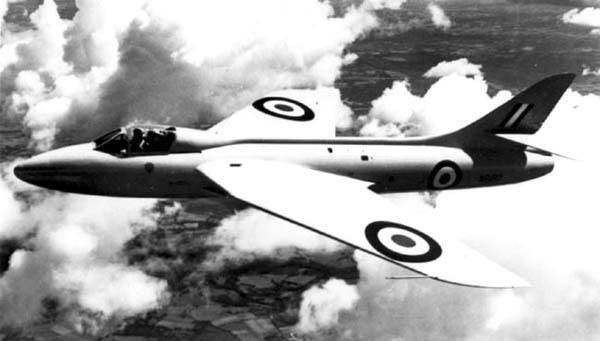
Tests were conducted at RAF airbases Boscombe Down, Dunsfold and Farnborough. In general, the prototype made a favorable impression on the military and the testers, and even participated in the traditional air parade in Farnborough. Soon the plane, which flew a little more than 11 hours, was returned to the factory for refinement. After replacing the pilot engine with the serial Avon RA.7 and making changes to the tail in April 1952, the plane took off again. During tests in horizontal flight, the 0,98 M speed was achieved, and during a dive it was possible to accelerate to 1,06 M. In May, the second prototype broke off from the factory strip of 1952, which, taking into account comments and changes, was to become a benchmark for serial fighters. The second prototype received a more comfortable, ergonomic and spacious cabin. Determined and the name of the aircraft, he entered history Aviation as "Hunter" ("Hunter"). At the end of November, the third prototype took off. It was built taking into account the risk of loss during the tests of the first two aircraft, but, fortunately, everything went smoothly for British test pilots and engineers.
After the “Hunter” successfully completed the flight test cycle, the aircraft was launched into a series at once in three British factories. Hawker assembled F.1 Hunter modification fighters with Rolls-Roys Avon RA.7 TRD with 3400 kg bollard in Blackpool and Kingston. At the beginning of 1954, the first 20 serial fighter aircraft of the F.1 modification were betrayed by the Air Force. All of them were used only for familiarization flights and to identify weak points in the structure. In fact, the first production aircraft were in trial operation and were not involved in combat service. Somewhat later, with a delay of almost 10 months, Hunter F.2 fighters, built at the Armstrong-Whitworth enterprise in Coventry, began to arrive at the combat units, with the Sapphire assault engines ASSA.6 with 3600 kg load. In total, the 194 fighter of the F.1 and F.2 modifications was assembled.
Approximately to the middle of 1954, the identification and elimination of “childhood diseases” took place, and new, more perfect modifications were created in parallel. 7 September 1953 on the extremely lightweight model “Hunter” F.3 with a forced engine 4354 kg and improved aerodynamics was set a world speed record - 1164,2 km / h. However, this modification was originally designed as a record and was not built in series. The first version of the fighter, suitable for combat service, was F.4.
Its construction began in October 1954. On the modification F.4 introduced a number of improvements and innovations designed to improve combat and operational characteristics. The most important difference from the previous models was the appearance of pylons for discharged fuel tanks, bombs or rockets and an increase in domestic fuel reserves. To ensure the safe salvo firing of four guns based on the results of operating the F.1 and F.2 models, they refined the ventral artillery installation, reinforcing the carriage, and to prevent damage to the aircraft skining by throwing out cartridges and tape links to collect them, they introduced a special capacity. On the F.4 modification, they began to install an improved Avon 121 engine, less prone to surge when firing. A total of two factories built 365 fighter of this modification.
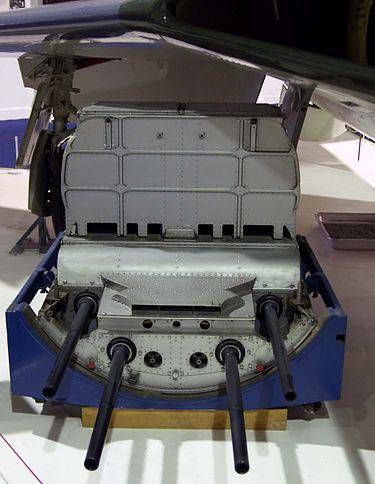
Placement of all artillery weapons on one quick-detachable gun carriage proved to be very successful. This allowed us to significantly speed up the preparation of the aircraft for re-combat sortie. The carriage with the finished ammunition was dismantled, and in its place another one, previously equipped, was suspended. Everything took less than 10 minutes. The plane had a fairly simple sighting equipment: a radio range finder to determine the distance to the target and a gyro scope.
For the Royal Air Force was characterized by a very unusual approach to the training of pilots. Launching a new fighter into the series, the Air Force leadership completely missed the training of flight personnel. The “Hunter” pilots were previously prepared on outdated direct-wing aircraft: “Vampire Trainer” T.11 and Meteor T.7, after which they were immediately transferred to combat fighters. Naturally, this situation led to a large number of flight accidents. A few years after the start of serial production of the fighter, October 11 1957, the double training “Hunter” T.7 took to the air. The aircraft was distinguished by a reinforced wing, a cut-off armament, and a two-seat cockpit with pilots side-by-side, trimmed to 1-2 guns.
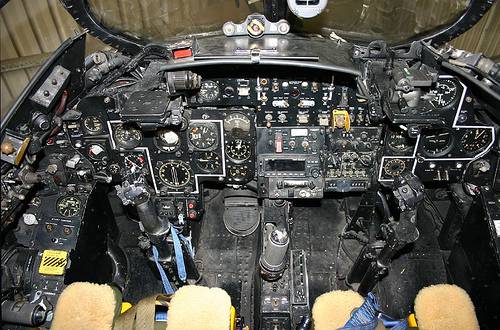
The main part of the two-seater "Hunters" was not rebuilt, but was reworked from the fighters of modification F.4. Over time, in each squadron of the British “Hunters” one TCB T.7 appeared. Total for RAF built 73 training aircraft. The export version of the TCB was designated T.66.
In 1956, the F.6 modification went into series. It was already a full-fledged combat aircraft with an acceptable level of technical reliability. After the introduction of the Avon 200 engine with the 4535 kg, it was finally possible to beat the surge in all flight modes. Thanks to the increase in the aircraft's thrust-to-weight ratio, the maximum flight speed increased, reaching the 0,95 M value, the climb rate and the ceiling increased. On the “Hunter” F.6, significant changes were made to the controls and, in general, the aerodynamics of the car was improved. Also due to the introduction of special compensators at the ends of the gun barrels, it was possible to improve the accuracy of shooting. Fighters modification F.6 received new radio equipment. Until the end of 1957, the 415 Hunter F.6 fighters were built in Britain, and a part of the earlier versions were also converted into this modification.
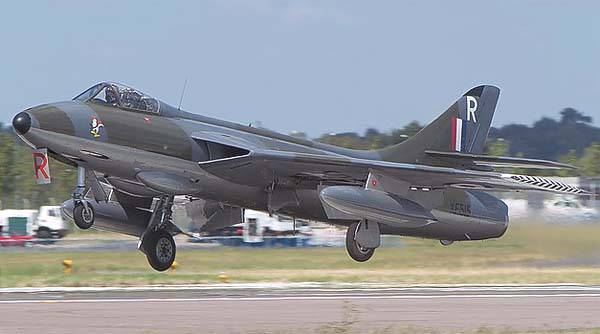
Many potential foreign customers liked the fighter with extremely powerful weapons, which at that time had good flight data. Pilots of medium qualification were able to fly freely on the Hunter, the design was quite thoughtful and British-style. This commercial success came after a series of overseas tours and military trials in the Middle East, the United States and Switzerland. The high combat potential of "Hunter" was noted by the famous American test pilot C. Yiger. This led to the fact that the Americans allocated money to establish licensed production of the British fighter in Belgium and Holland. In all, before the end of 1959, the 512 “Hunters” F.4 and F.6 were built in these two countries. Especially for Sweden, based on F.4, Hawker has developed an export version of F.50. From the British "four", this machine differed wing profile, engine "Avon" 1205 and Swedish avionics. Already during operation, the Swedes adapted the Hunters for the suspension of the Rb 324 and Sidewind missiles.
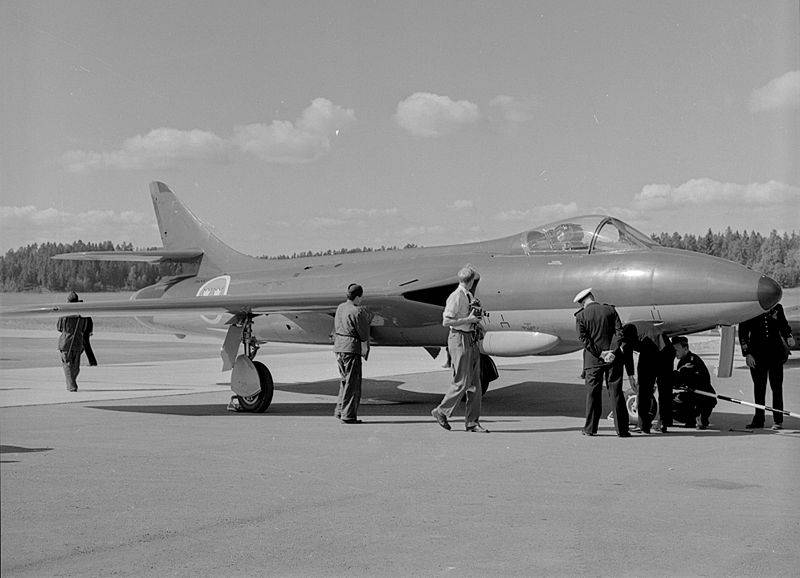
In 1955, the Hunter F.4 purchased Peru from the UK. The batch of 16 aircraft underwent a refurbishment and partial refit. The aircraft received the designation F.52 and differed from the basic version of the American navigation equipment. In the 1956, the 30 fighter aircraft of the F.51 modification received Denmark. In contrast to the machines designed by Sweden, these aircraft were installed 120 Avon TRD and British-made avionics. India has become one of the biggest buyers of the Hunters. In 1957, this country ordered the 160 F.56 Hunter aircraft, which differed from the British Six in the presence of a braking parachute. From 1966 to 1970, India also bought about fifty FGA.56A fighter-bombers, close to the FGA.9 modification, which will be discussed below. In 1957, Hunter F.6 won the competition for a new fighter in Switzerland. It is noteworthy that in addition to the English car, it was attended by: “Saber” of Canadian production, Swedish J-29 and MiG-15, assembled in Czechoslovakia. The victory in the Swiss competition subsequently had the most favorable effect on Hunter’s export orders. Total Switzerland received 100 fighters. After the delivery of 12 F.6 from the Royal Air Force, in accordance with the updated requirements of the Swiss Air Force, the construction of the improved F.58 began. In the Alpine republic itself, the fighters underwent a number of improvements. They installed bomb sights and missiles air battle "Sidewinder." In the 70-x TRD "Avon" 203 was replaced by "Avon" 207. Starting from 1982, the aircraft received a radar warning system and heat trap blocks as part of the Hunter-80 combat capabilities program. The refinement of the suspension units and the avionics made it possible to use modern aircraft armament: BL-755 bomb cassettes, air-to-surface AGM-65B guided missiles and adjustable GBU-12 bombs.
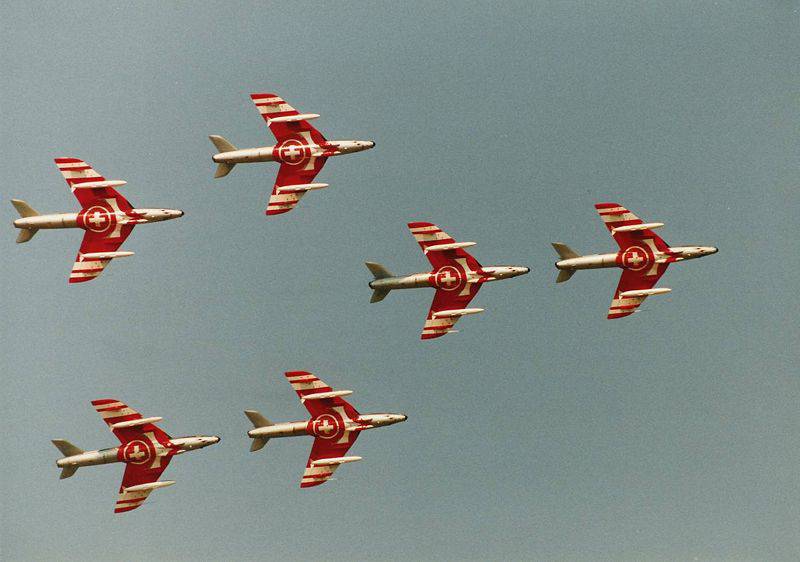
In Switzerland on the "Hunter" for a long time flew aerobatic aerobatics "Patrol Svis". Operation of the British “Hunters” in the Alpine Republic continued until the middle of the 90-s, they were written off in connection with the end of the “cold war” after reaching an agreement to buy F / A-18 Hornets in the USA.
In the English parts of the "first line" service "Hunter" was not too long. For an effective fight with Soviet bombers, the plane clearly lacked its own radar and guided missiles. In addition, already in the middle of the 60-x fighter began to lag behind the new bomber at maximum speed. This led to the fact that already in the 1963 year, all the British "Hunters" withdrew from Germany. But given the fact that the resource of most machines of later modifications was still very significant, it was decided to adapt them for other needs. As part of the alternative use of outdated 43 fighters, the F.6 was converted into FR.10 photo reconnaissance aircraft. To do this, three cameras were installed in the bow instead of the radio range unit, and armor appeared under the cabin floor.
For the Navy at the beginning of the 60's, the 40 fighters of the F.4 modification were turned into a deck-mounted TCB GA.11. At the same time, the guns from the planes were removed, and the wing of the aircraft was strengthened. Four pylons were left to accommodate the weapons. Radio range finder and navigation finder from cars dismantled. As a result, the plane became much easier and more maneuverable. Disarmed fighter aircraft were used to perform a wide range of tasks: imitation of landing on an aircraft carrier and during training bombing and shooting at the NAR.
Very often, these aircraft were depicted in the exercises of a simulated enemy and were used to calibrate the radar stations of warships. Several naval "Hunters" were converted into PR scouts. 11 A, their forward fuselage was made similar to FR.10. By analogy with the T7 trainer used in the Air Force, the T.8 modification was created for the Navy.
This double machine was equipped with a brake hook and was used for testing takeoff and landing from the deck of an aircraft carrier. Part of the machines received the avionics of the deck-mounted bomber "Bakenir". After the refusal of the Royal Navy of full-fledged aircraft carriers, the Hunters were used for a long time as flying laboratories for testing various electronic systems and weapons. In the British navy, the training hunters served until the beginning of the 90-s and were written off simultaneously with the Bakenir bombers.
In 1958, the Royal Air Force issued the Hawker company a design task for a specialized shock modification. The aircraft, designated FGA.9, distinguished by a new reinforced wing with four pylons, first flew into the air on July 3 1959 of the year. On pylons, discharged fuel tanks with a capacity of 1045 liters or bombs, NAR and napalm tanks weighing up to 2722 kg could be suspended. Total for the British Air Force 100 machines were redone.
Due to the heavier wing and the presence of suspension assemblies, the flight data of the Hunter impactors somewhat deteriorated. Thus, the maximum speed dropped to 0,92 M, and with the suspension of four tanks it was 0,88 M. But at the same time, the shock capabilities of the not yet old car increased significantly, which significantly extended the life of the British Hunters in the changed conditions. The main armament of FGA.9, in addition to guns, were the NAR. Initially, beams were installed for 76-mm unguided rockets of the Second World War, later blocks with Matn 68-mm missiles became standard.
Shock modification FGA.9 used in the external market is not less, and maybe even more popular than the net fighter. For conversion into a fighter-bomber, Hawker in 60 even bought up Hunters in Belgium and the Netherlands. The cost of the shock Hunter FGA.9 after repairs and upgrades in 1970 was 500 000 pounds. Impact modifications intended for export were, as a rule, equipped with an Avon 207 TRD and a reinforced wing. In addition to FGA.9, there were also purely export options: FGA.59, FGA.71, FGA.73, FGA.74 FGA.76, FGA.80. The aircraft differed in type of engine, equipment and composition of weapons in accordance with national preferences. Simultaneously with the fighter-bombers for export were photo reconnaissance on the basis of "Hunter". Six FR.71A were sold in Chile, and three FR.76A were sold in the UAE.
The geography of deliveries was very wide. Iraq was the largest recipient of the “Hunter” drums, to which 42 FGA.59 and FGA.59A and four scouts FGA.59B were sent. Singapore ranks second, with 60 FGA.38, FGA.74A and FGA.74B receiving 74 at the end. Also, the modernized “Hunters” were in service in Chile, India, Jordan, Kuwait, Kenya, Lebanon, Oman, Peru, Qatar, Saudi Arabia, Somalia, Rhodesia, Zimbabwe.
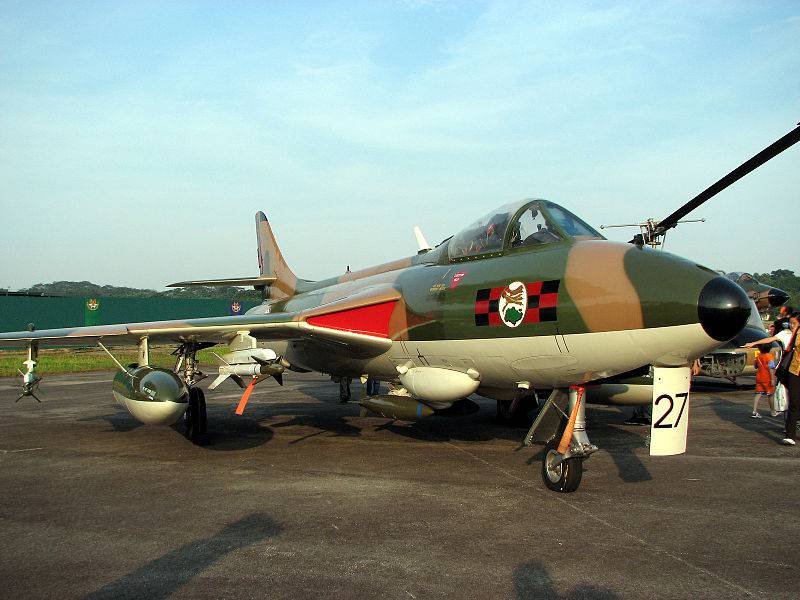
The combat biography of the Hunters was very intense. For the first time, British fighters of this type were involved during the Suez 1956 crisis of the year to accompany the Canberra bombers. In 1962, the Hunters launched assault attacks on the rebels in Brunei. From 1964 to 1967, the year 30 FGA.9 and FR.10 fought against the rebels in Yemen. In the air strikes, the old 76-mm NAR and 30-mm guns were mainly used. Combat work was carried out with great intensity, British aircraft often made 8-10 sorties a day. "Hunters" operated at extremely low altitudes, and several aircraft were lost from small arms fire. weapons. As a rule, the hydraulic system was amazed, and the pilot was forced to eject, or make an emergency landing. Despite the local successes achieved as a result of the bombing, the British lost the campaign in Yemen and left the country in 1967. In 1962, the English FGA.9 from the 20 squadron took part in the officially undeclared war against Indonesia. Planes stationed on the island of Labuan, raided the partisans occupied villages in Borneo. In August 1963, the "Hunters" of the British Air Force resisted the Indonesian amphibious assault forces. The British seriously feared the MiG-17 and MiG-21 fighters delivered from the USSR. The fighting ceased in 1966 after the overthrow of President Sukarno as a result of the military coup.
In the Middle East, “Hunters”, since 1966, have had a chance to take part in clashes with Israel and in numerous strife. The first to fight 11 November fighters entered the Jordan Air Force. Inadvertently raised by the intercept of the six Israeli Mirage IIICJ, four "Hunters" got involved in a hopeless air fight, having lost the fighter Lieutenant Salti, the pilot was killed. Later, a series of air battles with the Mirage took place. It was reported that during the battle one "Mirage" was damaged and subsequently crashed. In 1967, during the Six Day War, Jordanian Hunters were involved in attacks by Israeli airfields. During the response bombings at the cost of losing one Israeli aircraft, all the 18 fighters-bombers in the Jordanian air force were destroyed. In the period from 1971 to 1975, Jordan acquired several Hunter parties in different countries in sufficient quantities to form a squadron. In 1972, during the border conflict with Syria, one plane was lost from anti-aircraft fire. 9 November 1972 attempted a coup d'etat in Jordan, while the Hunter pilot, captain Mohammed Al-Khatib, who had gone over to the coup, attempted to intercept the helicopter with King Hussein, but was shot down by F-104 fighters whose pilots remained loyal to the king.
1967 also suffered heavy losses in Iraq’s FGA.59. From the very beginning, an unfavorable situation developed for the Arabs. The Israeli Air Force managed to destroy a significant part of the aircraft of the Arab coalition at airfields and win air supremacy. During the air battles, the Iraqi Hunters shot down two Vautour IINs and one Mirage IIICJ, losing two planes. During the next war in 1973, the Iraqi Hunters, together with Su-7B, bombed Israeli strongholds and airfields. According to Iraqi data, in the air battles, Hunters managed to shoot down several Skyhocks and SuperMisters, while five aircraft were shot down by Mirage and two anti-aircraft guns. The surviving Iraqi Hunters after 1973 were regularly used to bomb the Kurds in the north of the country. By 1980, the 30 machines remained in the ranks, and they took part in the war with Iran. In 1991, several Iraqi “Hunters” still flew into the air, heavily worn-out vehicles were no longer present in combat value and were used for training flights. All of them were destroyed during the “Storm in the Desert”.
The longest among the Middle Eastern countries "Hunters" served in Lebanon. For the first time, the Lebanese "Hunters" went into battle in 1967 year. 6 June 1967, two Lebanese aircraft were shot down by Israeli anti-aircraft gunners during a reconnaissance flight over Galilee. In 1973, there were 10 Hunters in Lebanon, naturally they could not resist the Israeli Air Force and were quickly destroyed. In 1975, nine more machines of various modifications were purchased to compensate for the losses. The Hunters took an active part in the 1983 battles against the Druze armed formations. Since all Lebanese airfields were destroyed, the aircraft made combat missions from the highway in 30 km from Beirut. It is known about two shot down "Hunters", one hit by ZU-23 fire, another fighter-bomber hit the Strela-2 into the engine nozzle. A few more cars received serious damage, but were able to return. The last two Lebanese “Hunters” are written off in 2014.
Indian "Hunters" for the first time engaged in a combat situation in the 1965 year during the Indo-Pakistani war. Prior to that, in 1961, fighters recently received from the UK covered the entry of Indian troops into the Portuguese colony of Goa. During the Indian offensive in Kashmir in September 1965, the Hunters launched bombing attacks on airfields and positions of Pakistani troops, as well as providing air defense. In the three-week 1965 conflict, India in air battles with Pakistani F-86 and F-104 fighters and lost 10 Hunters from anti-aircraft fire, while the Indians shot down 6 Pakistani planes.
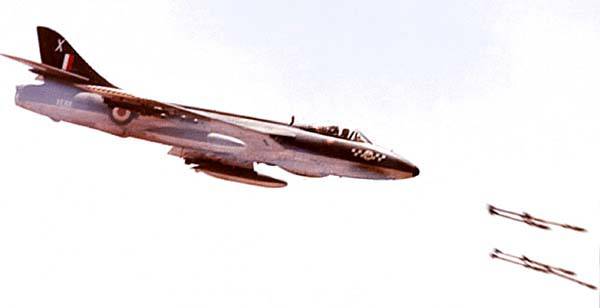
The Hunters played a very prominent role during the next war with Pakistan in 1971. Due to the good cooperation between the Air Force and the ground forces of India, as well as the competent use of powerful armored kulaks, the war ended in a crushing defeat of Pakistan, as a result of which East Pakistan became an independent state of Bangladesh.
At that time, there were already more than a hundred "Hunters" in the Indian Air Force; six squadrons were involved in the fighting. Using a powerful battery of four 30-mm cannons and unguided rockets, fighter-bombers smashed Pakistani military bases, fuel and ammunition depots, railway stations, radar stations and airfields, as well as paralyzed enemy communications. In this conflict, the “Hunters” have performed well in the fight against armored vehicles. However, the losses were also significant, Pakistani fighters and anti-aircraft artillery, according to Indian data, managed to shoot down 14 aircraft. The main losses Hunters incurred in air combat with F-86, J-6 (Chinese version of the MiG-19) and Mirage-3. In turn, the Hunter pilots shot down three Saber and one J-6. More than half of Indian fighter-bombers were hit by sidewalk missiles. The significant losses of the “Hunters” are explained by the fact that Indian pilots focused on striking the ground were poorly prepared for air combat and did not have air-to-air guided missiles.
After the victory in the War of Independence of Bangladesh, the Hunters' combat career did not end. The aircraft were regularly engaged in launching assault attacks during numerous armed incidents on the Indo-Pakistan border. In the summer of 1991, the last Indian combat squadron surrendered its single FGA.56 and training T.66 and relocated to MiG-27, but the Hunters in the Indian Air Force were used as tugs in the Indian Air Force until the end of the 90.
In 1962, armed clashes between government forces and Bedouins began in the Sultanate of Oman. For 12 years, the troops of the Popular Front for the Liberation of Oman, supported by South Yemen, managed to take control of most of the country, and the Sultan of Qaboos appealed for armed assistance to Britain, Kuwait and Jordan. Of these countries, two dozen "Hunters" of various modifications were supplied. Foreign pilots took part in the sorties. Soon, the battles took on a fierce character, the Hunters were opposed by the Shilka ZSU, 12,7-mm DShK, 14,5-mm PGI, 23-mm and 57-mm towed anti-aircraft guns and Strela-2 MANPADS. At least four "Hunter" were shot down and somewhat written off as unrecoverable. At the end of 1975, thanks to foreign aid, the rebels were forced out of Oman. The Hunters were in service in this country before 1988.
The first on the African continent to join the battle "Hunters" Air Force Rhodesia. As of 1963 year, there was 12 FGA.9 in this country. They actively attacked both the rebel-controlled Rhodesian territory and the camps in Botswana, Mozambique, Tanzania and Zambia. Rhodesian "air hunters" in the local aviation workshops have been refitted with the aim of using modern high-performance cluster munitions in tropical jungle conditions. During the raids on Zambia, the Hunters accompanied the Canberra bombers, as they feared interception by the Zambian MiG-17. Despite the fact that the partisans had at their disposal the 12,7-mm, 14,5-mm, 23-mm and Strela-2 anti-aircraft missiles, only two Hunters were shot down with anti-aircraft guns, although the aircraft repeatedly returned with combat damage.
In 1980, the black majority came to power, and Rhodesia was renamed Zimbabwe. At the same time, the Air Force replenished five "Hunters" donated by Kenya. Soon the guerrilla leaders did not share power, and civil war broke out again in the country, and the Zimbavian “Hunters” again began to bomb the jungle and long-suffering villages. In July, 1982, the rebels attacked Thornhill airfield, with several vehicles destroyed. However, in Zimbabwe, Hunters were actively used until the end of the 80s.
Chilean fighters “became famous” in September 1973 of the year, while the “Hunters” struck several blows at the palace of La Moneda in the center of Santiago during a military coup. As a result, this most negatively affected the combat readiness of the Air Force combat aircraft of Chile. After the assassination of President Salvador Allende, the British government imposed an embargo on parts supply, which lasted until 1982. In the middle of the 80, some of the Chilean Hunters underwent a refurbishment and modernization. Radar radiation warning sensors and heat trap blocks were installed on the aircraft. This made it possible to extend the service life until the start of the 90-x.
Designed for use as an interceptor for air defense "Hunter" quickly outdated. The use of this incarnation was hindered by two circumstances: the absence of radar onboard and guided missiles in the armament. But the plane had many indisputable advantages: ease of operation, simple and durable design, unpretentiousness to the conditions of basing, good maintainability, high climb rate and powerful armament. The strength of the subsonic aircraft was the ability to conduct a maneuverable defensive battle with more modern fighters. All this at a relatively low cost made it almost the ideal strike aircraft for poor third world countries.
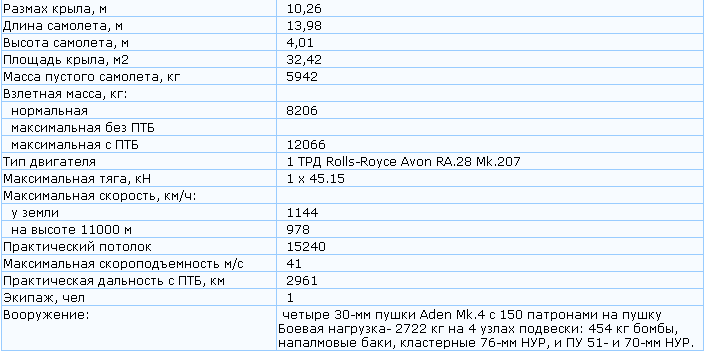
Currently, all the "Hunters" removed from the Air Force of the countries where it was in operation. However, this does not mean that the flight biography of the aircraft came to an end. There are still a lot of “Hunters” of various modifications in private hands. “Hunters” regularly make demonstration flights at various air shows. Moreover, airplanes of this type are used in the process of combat training of US forces.
In the past decade, there has been a rapid growth in private companies in the United States, specializing in the provision of training and training services for the American and foreign military. It is known about several private companies operating foreign-made aviation equipment for use in military exercises and various training sessions (for more details see here: US private aviation military companies).
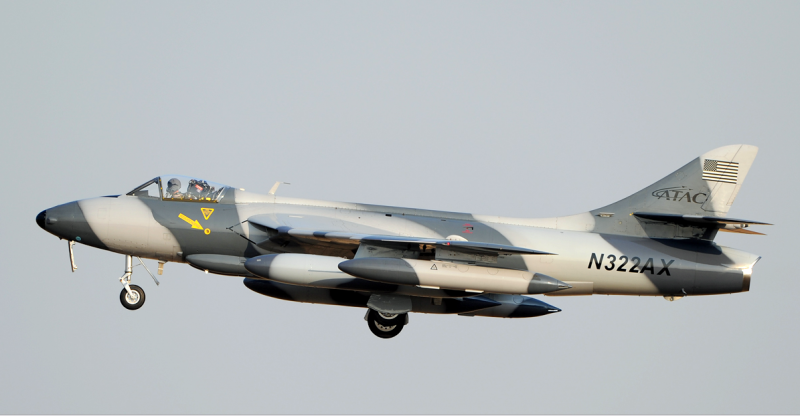
One of the largest and most promoted companies is ATAS (Airborne Tactical Advantage Company). The company was founded by former high-ranking military and pilots of the Air Force and Navy. The ownership of ATAS is mainly aircraft built in the 70-80's. Winged cars purchased at a reasonable price in different countries, despite their age, are in good technical condition and, as a rule, have a significant residual life. In addition to other foreign combat aircraft, there are several “Hunters” in the fleet of the American aviation company. These cars were bought all over the world and were restored in the repair shops of the company. At the same time, together with the planes, a set of certified consumables and spare parts was purchased; this, in combination with the hard work of the technical staff, allows for trouble-free operation.
At the exercises of the Navy, the ICP, the Air Force and the air defense units of the US Ground Forces, the Hunters usually portray enemy attack aircraft trying to break through to a protected object at low altitude. In order to increase realism, in order to maximally approach the real combat situation, the simulators of the GOS PKR and EW systems are installed on the aircraft. ATAS airplanes are permanently stationed at Point Mugu airbase (California) and regularly participate in exercises at airbases: Fallon (Nevada), Kaneohe Bay (Hawaii), Zweibrücken (Germany) and Atsugi (Japan).
Based on:
http://hunterteam.com
http://www.dhc-2.com/UK.html
http://www.mig17.com/new_page_2.htm
http://www.rafmuseum.org.uk/london/collections/aircraft/hawker-hunter-fga9.cfm
http://www.airwar.ru/enc/fighter/hanterfga.html
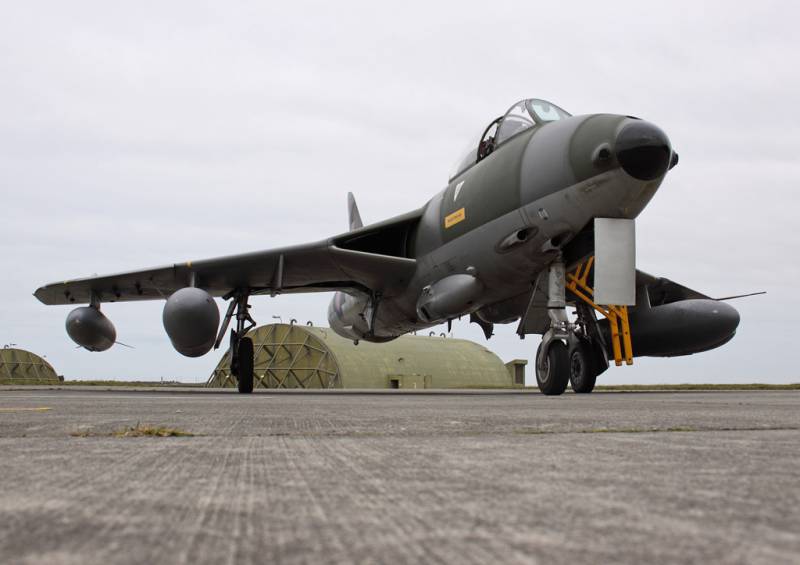
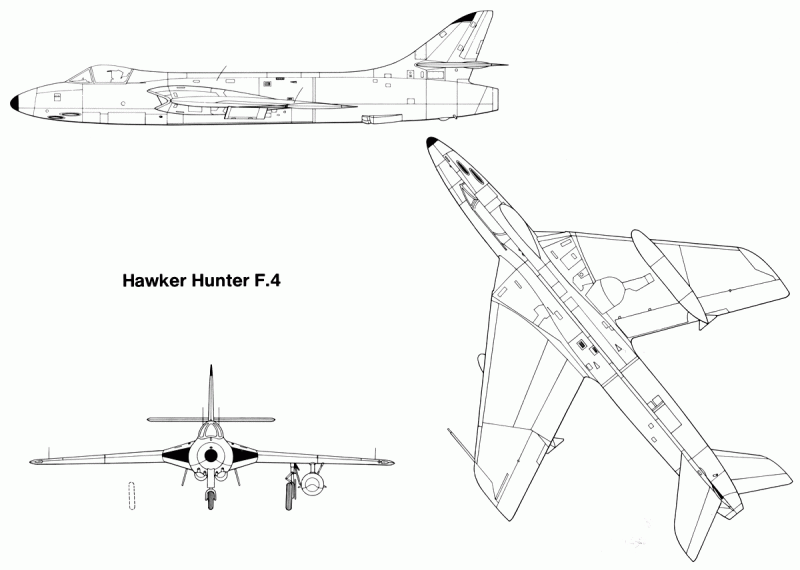
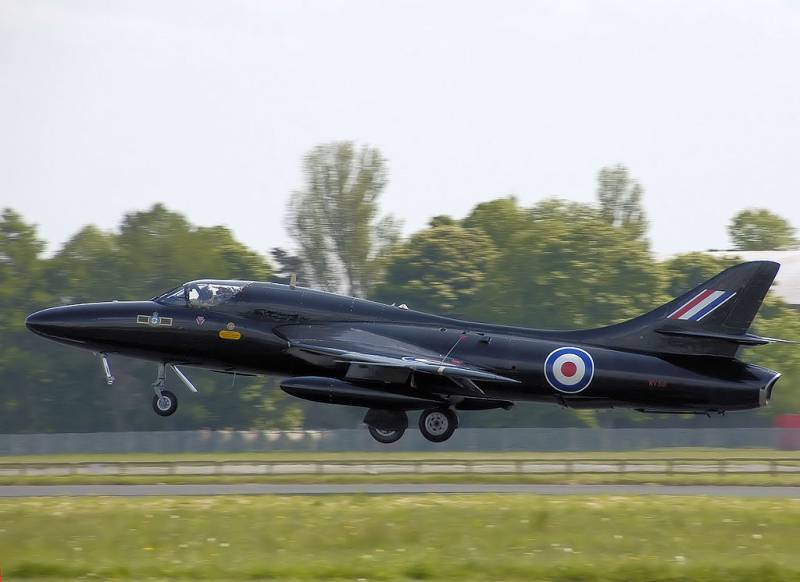
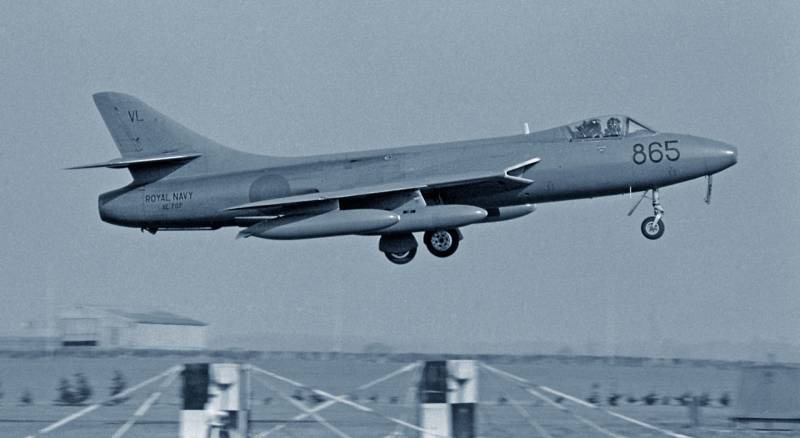
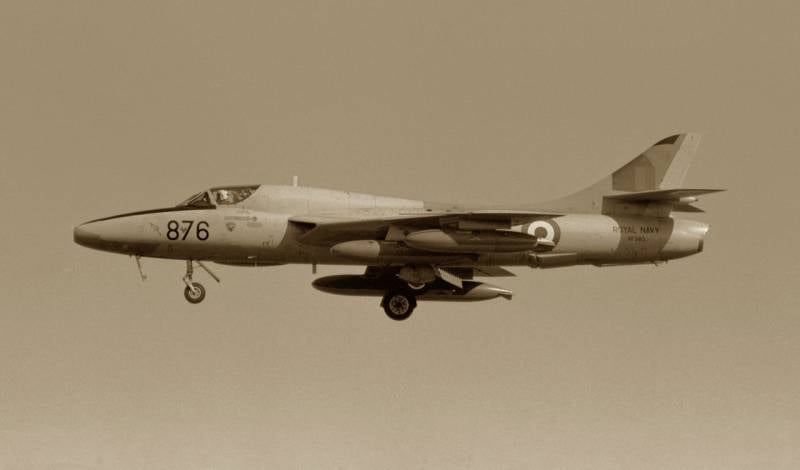
Information